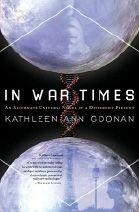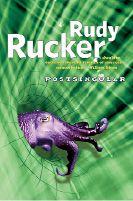Science Fiction: The 101 Best Novels 1985-2010 (48 page)
Read Science Fiction: The 101 Best Novels 1985-2010 Online
Authors: Damien Broderick,Paul di Filippo

On Edgar Rice Burroughs’s Mars, there lived a strange bipartite race. Half the race had the form of disembodied heads with some small appendages; the other half of the race were headless bodies. Of course, the headlings used the brutes as vehicles. Out of this pulp cliché, Carol Emshwiller, in an unwaveringly futuristic voice, fashioned a profound novel of amazing depth and intimacy.
The Mount
takes place on a future Earth where an alien race of conquerors known as the Hoots employ subjugated humans as their rides. Charley is a teenaged Mount who happens to be assigned to the Hoot child who will one day become the leader of the invaders. As the wild humans still at large launch a successful rebellion, Charley finds his loyalties torn between his master and his species. In the end, the pair forge a third way between the opposed camps. Dealing with issues of slavery and freedom and the awkward bonds between father and child, this novel belongs on the shelf with such classics as Tom Disch’s Mankind Under the Leash and William Tenn’s Of Men and Monsters.
Relatively soon after this triumph came an ever stronger work,
The Secret City
.
This novel is narrated alternately from two points-of-view, both alien. The first such being we meet is Lorpas, known to humans as Norman North. Like all his kind, Lorpas does not originate on Earth. Fifty years ago, a small party of aliens arrived here secretly as tourists. They became stranded. The elder generation gradually died off, leaving a few youngsters now grown to exiled adulthood. These remnants are almost as much human—by culture—as they are natives of their home planet, Betasha. They wander the planet, never daring to assimilate, hoping for a rescue mission that, so far, has never arrived. Lorpas is typical, an itinerant homeless hybrid, sensitive and intelligent, but never allowed by circumstance to reach his full potential.
Finally, after an uncomfortable run-in with the police, he determines to find the Secret City, a legendary refuge in the mountains where many of his kind have supposedly gone to ground. So he sets out into the California alpine wilderness.
The Secret City proves to be nothing more than a primitive encampment where only three remaining Betashans live: Mollish, an old woman; Allush, a young woman (and our second narrator); and Youpas, a feral young man who hates Earthlings—and who comes to hates Lorpas, as a rival for Allush’s affections.
The plight of this foursome is complicated immensely when the rescuers from Betasha finally turn up—with all the disdain that “civilized” purebreds can have for dirty savages. And when a human rancher named Corwin and his beautiful daughter Emily are drawn into the picture, the group dynamics become even more chaotic.
Aliens living in secret among humans is another of Rudy Rucker’s sf “power chords”—an sf trope so strong that it can be endlessly reworked. It’s stimulating to see such a fine, accomplished and subtle writer as Emshwiller having a go at it.
The genre holds a number of vivid prior examples. Perhaps the most famous is Zenna Henderson’s series involving “the People” (collected in
Ingathering
), and that’s a model it seems Emshwiller definitely has in mind. But there was also a more malign set of aliens intent on concealing themselves among us in the briefly broadcast but well-remembered TV series,
The Invaders
, and a little of this interpretation creeps into Emshwiller’s tale as well, in the actions of the brutal “rescuers” from Betasha. Algis Budrys’s
Hard Landing
is another relevant milestone. And finally, Steve Cash’s ongoing series about the Meq seems a close cousin to Emshwiller’s novel.
But all these past instances aside, no one has yet approached the trope with the finesse and grace of Emshwiller. She’s a writer of such slantwise sensibilities and such deep perceptions that she conveys the exotic weirdness of such a setup—and the almost unfathomable otherness of the Betashan mentality—with uncommon vividness and startling jolts of creepiness. Like Gene Wolfe, she filters actions through the perceptions of her characters in such a way that we are both drawn into the immediacy of her plot and simultaneously held aloof a bit. As in Wolfe’s
The Fifth Head of Cerberus
, we encounter the world through the not-always understandable eyes of another species. There’s a little bit, too, of John Crowley’s outré
Engine Summer
in the manifestation of the Secret City as overgrown labyrinth.
But ultimately, especially through the love story between Allush and Lorpas, we come to cherish these aliens and realize their virtual identity with us. Perhaps that’s always the essential message of this particular power chord: there’s no real need to hide, for we’re all brothers and sisters under the skin—if we can overcome our prejudices, that is.
90
Kathleen Ann Goonan
(2007)

ON DECEMBER 7
, 1941, “a date which will live in infamy,” Japanese military made an undeclared act of war on US forces stationed in Pearl Harbor, Hawaii, killing 2335 soldiers and sailors and 68 civilians, sinking the Battleship USS
Arizona
with the loss of 1104 lives. On the evening before the attack, in Kathleen Goonan’s novel of time shifts and jazz, Sam Dance—an “uncoordinated soldier” with poor eyesight—is seduced by an exotic European physicist:
Dr. Eliani Hadntz was only five foot three, though she had seemed taller in the classroom, and Sam had not suspected that her tightly pulled-back hair was a mass of wild black curls until the evening she sat on the edge of his narrow boardinghouse bed. A streetlamp threw a glow onto her pale breasts…. He had no idea why she was here.
Throughout the novel, Dr. Hadntz slips in and out of Sam’s life, twisting history from the bloody path it has taken in our chronicles toward a utopian alternative that dances to the bebop arrhythmic cadences of the jazz that Sam and his best pal Wink love. It can’t be coincidence that Eliani Hadntz’s name speaks to our yearning for an alternative world where the worst excesses of a bloody twentieth century hadn’t happened. To young Sam, a brilliant but unschooled engineer, she brings the plans for an unexplained device that manipulates time by combining a “parallel spiral” (time’s multiple courses, and the DNA double helix) with the quantum uncertainties of consciousness. Hadntz reflects that
if human consciousness was the time-sensitive entity she believed it was, this device could be called a time machine… that affected the physics and consciousness of human behavior…. It would enable humans to use the constant expansion of the universe, in much the same way that the previously invisible power of electricity had been harnessed and was now put to all kinds of positive uses….
This beautiful Hungarian Gypsy scientist, who has left her 12 year old daughter in Nazi-occupied Europe in order to work with the Allies on an atomic weapon, has withdrawn from the Manhattan project in hopes that her time device can redeem the very nature of humankind. For Dance, though, mired in war work on magnetrons that will power weapons and radar, such hopes seem elusive. After his beloved brother Keenan is killed at Pearl Harbor, entombed in the
Arizona
, Sam is flung into the war effort, pursued by Major Bette Elegante of the OSS who wants to know more about the Hadntz device that Sam and Wink try to build. Of course he falls in love with Bette.
He witnesses atrocities and their consequences. Still, Dr. Hadntz’s conviction is that human nature can be shifted away from the brutish herd mentality and impulses that create war. “How can people treat one another this way?” she asks. “What I am thinking about is how to remove or change this propensity… this urge to be like all the others and to follow a leader blindly.…” Sam objects: “Turn the world into your breeding pen? Isn’t that what Hitler is trying to do?” No, says Hadntz heatedly. Her way does not involve murder but rather a cure for our innate stupidity.
What anchors these airy sf speculations is the density of Sam’s experience in the war and after it, some of this conveyed through his diary entries. And these in turn, Goonan has been quick to acknowledge, are drawn directly from her own father’s writings and war stories. Thomas Goonan tried for a year to enter the military despite his poor eyesight, finally did so, was chosen for special training and work on much the same advanced electronics as Sam, with Company C of the 610
th
Battalion. He was shipped to France in 1945, then to Germany, supplying troops on the Rhine with ordnance and equipment, and after the German surrender he and his friends opened a
biergarten
behind their billet in Muchanglandbach, just as Sam and Wink do, “liberating” huge quantities of wine, barrels, glasses.
Back in the States, amateur saxophonist Sam hangs out in the best jazz venues of the time, catching Dizzy Gillespie and Charlie Parker, and Monk at Minton’s in Harlem, wishing Wink were there, illuminated and astonished by the way these utterly new sounds let them feel and see the world in new ways. Or was Allen Winklemyer actually killed in Berlin? Time is unraveling. Jazz is a parallel to the intended action of the mysterious device that Sam continues to tinker with, even after a test version had melted down into a puddle of metal. Jazz resonates throughout the novel, informing the rhythms of the prose in key moments:
His brain became a device tuned and retuned by Bird’s notes; he was tossed like a plane in a wild storm across the astonishing sky of the man’s mind…. [Sam watched] the man bring the notes out from where they flocked within him, building pressure until they burst forth as complex fragments united by tone, by instrument, by his fast-moving fingers, a blur on the keys of his alto sax.
When time bursts forth in complex fragments united by a new kind of historical melody, and dead Wink reappears, Goonan merges her father’s recollections with an aspirational science fiction vision of a world that could be made differently. The hinge point of change will not surprise anyone who was young in the same era as Kathleen Goonan—she was born in 1952—but even much younger readers will feel a shiver to find Sam in a world where “the news was much different. Robert Kennedy was president, and JFK was still alive, a globetrotting philanderer…. Once they got into D.C. there was no sign of the highway construction that had threatened obliteration of whole neighborhoods.” They are in a different history, where Sam’s youngest children “had grown up in a world free of the threat of nuclear war, due to the Munich Disarmament Treaty negotiated by Khrushchev and Kennedy in 1964.”
In War Times
is a novel that, like Sam, embraces time’s released melody.
91
Rudy Rucker
(2007)

POSTSINGULAR,
with its sequel
Hylozoic
(2009)
,
are two-thirds of a trilogy—incomplete at the end of 2010—proposing that all matter is alive and adjacent “brane” realities can be contacted. This radical notion is more often found on the New Age shelves, but Rucker is a mystic with solid mathematical credentials, and his zany vision of the near future is a very different Singularity and aftermath than those of Anderson, Barnes, Doctorow, Stross, or Vinge himself.
